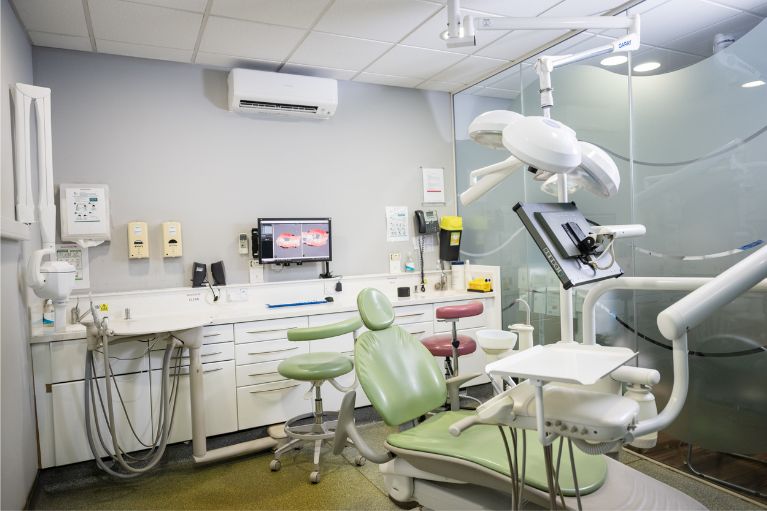Glossary of Dental Implant Terms

Below are definitions of just a few of the many terms used in implant dentistry:
Abutment = A connector that the dentist builds onto, or attaches, to the top of a dental implant. It serves as the attachment for the replacement tooth, crown, or bridge and keeps it firmly in place.
Abutment teeth = Provide support to a bridge or partial denture. The bridge is attached to the abutment tooth during a full crown or inlay/onlay prep. On the other hand, a partial denture is supported by clasps or rests on the abutment tooth.
Anchorage = A way of resisting movement of a tooth or number of teeth by using different techniques.
Antirotation = A structural feature of some endosteal dental implant components that prevents relative rotation of fastened parts. This feature may exist between a dental implant body and the dental implant abutment, and/or the dental implant abutment and dental implant abutment element(s).
Atrophic mandible = Jawbone loss (decreasing/declining in size).
Ceramic = This is the material that’s used to make dental implants. It’s made of clay and hardened by heat before being placed in your mouth. Some people prefer ceramic over titanium because it offers a more natural-looking appearance. It’s also available in ivory so it closely resembles existing teeth and roots.
Crown = Also known as a cap, replaces a single tooth. It’s often used to replace a broken or lost tooth as a result of infection, decay, injury, or other oral health problem. The crown is typically fitted over the top of existing teeth or attached to the abutment of a dental implant.
Dental bone graft = Adds volume and density to jaw in areas where bone loss has occurred. The bone graft material may be taken from your own body (autogenous), or it may be purchased from a human tissue bank (allograft) or an animal tissue bank (xenograft).
Dental Implant = Also known as a fixture, is a medical device that interfaces with the jawbone to support a dental prosthesis, like a bridge, crown, or denture. The implant fuses with the bone through a process called osseointegration, providing long-lasting and durable results. There are three main types of implant:
- Endosteal Implant = It is the most common type of implant used by dentists today. To fit this implant, your dentist will place small screws, plates, blades, or cylinders into the jawbone during a surgical procedure to hold at least one prosthetic tooth. There are two types of endosteal implants—cylinder and blade. Cylinder implants are titanium screws and are the most commonly-used endosteal implant. Blade implants are thin, flat titanium pieces that may be used when the alveolar process (the part of your jawbone that holds your teeth) has atrophied. Both types of endosteal implants have a post (abutment) that sits above the gum tissue, onto which the prosthetic tooth or teeth are eventually placed.
- Subperiosteal Implant = This type of implant sits on the top of the jaw. The post of the metal framework protrudes through the gum, holding the prosthetic tooth (or teeth) in place. If a patient can’t use a denture, the dentist may use this method for attaching an implant. Subperiosteal implants are thin titanium frames, with an attached post, that are custom-made to fit the unique contours of each patient’s jawbone. The gum heals around the frame, securing it in place. A prosthetic tooth is then placed on the post that sits above the gum’s surface.
- Zygomatic and Pterygoid implant = A special type of dental implant. While regular implants are placed into the jawbone, zygomatic/pterygoid implants are designed to be anchored to the zygomatic bones (cheekbones). The zygomatic bones are used because some patients don't have enough jawbone mass to support a regular dental implant
Dentures = The most traditional method of tooth replacement. However, most patients don’t have the same success with them as they do with implants. Some can be removed daily for cleaning and storage, while others are attached permanently to the mouth (i.e., implant-supported dentures).
Edentulous = Teeth (losing teeth) (partial = one/some teeth, fully = no teeth).
Endodontics = The prevention, diagnosis and management of diseases of the tooth pulp and the tissues surrounding the root of a tooth.
Occlusal stability = The static and dynamic contact relationship between the occlusal surfaces of the teeth during function.
Oral transmucosal delivery = The systemic delivery of drug through the mucous membrane of the oral cavity.
Osseointegration = Bone ingrowth into a metal implant. An artificial implant is permanently, surgically anchored and integrated into bone, which then grows into the implant.
Periodontics = the branch of dentistry that focuses on the health of your gums and jawbone — the tissues that support your teeth.
Prosthesis = Artificial body part.
Titanium = Most modern dental implants are made of titanium, a lightweight but strong metal that can ossify with the jawbone. This metal has become widely used since very few people are allergic to it.
Zirconia = An alternative metal used for a small percentage of patients who are allergic to titanium. Since the risk of bacteria is lower, patients may experience better gum health with zirconia. It’s also white, so it closely resembles natural teeth.